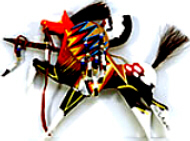![]()
|
|
|
|
|
|||||

Success Stories
 Virtual
Keeping House: A First Nation Gallery
Virtual
Keeping House: A First Nation Gallery
The Saskatchewan Indian Cultural Centre digitizes its art collection
Cathy Wheaton is one of the proud creators of an elegant and inviting digital gallery, an Internet web site showcasing Aboriginal Canadian art. When Wheaton began the site, she knew a great deal about First Nations artists and little about Internet technology.
AI know a lot about computers now, but when I started, I didn't even know what Windows(r) was," recalls Wheaton, a Woodlands Cree Indian from Saskatchewan's Lac La Ronge band.
Due to her extensive work with native artists, the Saskatchewan Indian Cultural Centre appointed Wheaton to lead a project funded by Industry Canada's Digital Collections program. The Digital Collectionss program, funded by the federal Youth Employment Strategy, has enabled over 1400 young Canadians (ages 15-30) to gain valuable work experience in the multimedia sector. By converting significant Canadian content for display on the Information Highway, Canadian youth have not only gained skills for knowledge-based employment but have provided greater access to Canadian holdings located in archives, libraries, museums, associations and other sources.
For Jim Bruce, the Cultural Centre's library director, the program offered a solution to a vexing problem. The Cultural Centre houses one of Canada's largest collections of Aboriginal art but lacks the space to properly display it. With today's technology, a digital record of each painting, handicraft and artefact could be published on the Internet.
Thus began the digital collection, Virtual Keeping House: A First Nations Gallery, a unique way for First Nations artists to gain instant world-wide exposure. Since native languages don't have a specific term for "museum" or "gallery", some use the term "keeping house" -- a house in which to keep items for display.
Wheaton, now 31 and completing a degree in Native Studies at the University of Saskatchewan led a team of three other First Nations students to create the web site. The group began by studying excellent web sites examples, such as those of national museums and art galleries. "Having looked at some sites, we knew what we wanted," Wheaton says. "That level of professionalism was what we were striving for in our images, and I think we accomplished that."
"But getting there," Wheaton says candidly, "was a learning process." For instance, the students had to learn how to photograph the art objects, some of them sheltered by protective glass, and to simultaneously capture their detail and their artistic integrity. The images were then transferred in digital format onto compact discs from which they could be used for display on the Internet or archived for future reference.
"As we watched the whole thing progress, the most striking thing was to finally see the art pieces on the computer," Wheaton recalls. "We were so proud of how the images turned out."
In addition to the technical skills they acquired, the students dismantled a web of copyright laws, and expanded their knowledge of Canadian Aboriginal art history.
The experience gave Wheaton an opportunity to manage people as well as to evaluate and direct her team's strengths. Furthermore, it gave her the opportunity to develop and enhance valuable relationships within the First Nations artistic community.
It's an experience she's unlikely to forget. "I think of this project as quite an impressive accomplishment, considering we were a bunch of summer students with no experience at all in technology."
Visit the SchoolNet Digital Collections World Wide Web Site at http://collections.ic.gc.ca
|
Updated: |